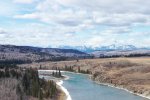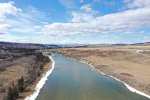You are using an out of date browser. It may not display this or other websites correctly.
You should upgrade or use an alternative browser.
You should upgrade or use an alternative browser.
2 Pro Canadian Rocky Mountains!
- Thread starter Mavicrpo8808
- Start date
Bryan L
Well-Known Member
I'm pretty new so I do not know what a ND filter is, however when I bought the Mavic pro 2 there was a filter pack that came with it. For this picture there was no filters attached to the camera. I well need to learn more about the filters before I out any on.Were you using an ND filter? Beautiful country!
An tha k you very much I appreciate it!
DaveS
Well-Known Member
ND stands for "Neutral Density". These filters cut down the amount of light that reaches the sensor. You want that on a bright sunny day because it helps you control the look of the shot. Sometimes, at least here in Texas, it can be so bright on a sunny day that even if you stop down the iris to f22, the whites and lights are blown out. An ND filter will eliminate that. The higher the number on the filter, the more it decreases the light. Typically you see ND's in 4, 8, 16, maybe 32 for drones. You will see even higher numbers but those are for creating a special look. For example, you photograph a waterfall with an ND 64, use a slow shutter speed, maybe a low iris setting and the water looks blurry while everything around it is in sharp focus. This is tough to do with a drone because the camera, in that case, needs to be very still. You can get even less numbers on ND, like .05 or 512! You can also get a Variable ND filter which is one filter where you dial in the strength you want. Those are very popular with drones because you don't have to change the ND, just land and dial is more light reduction. Get good ones from Tiffin, PolarPro, Freewell or PGYTECH. Our colleagues on this forum will have ideas based on what they use.I'm pretty new so I do not know what a ND filter is, however when I bought the Mavic pro 2 there was a filter pack that came with it. For this picture there was no filters attached to the camera. I well need to learn more about the filters before I out any on.
An tha k you very much I appreciate it!
Hey Thank know so much for that info super appreciate it. There is so much to learn about filters and the camera and this gives me a great start!ND stands for "Neutral Density". These filters cut down the amount of light that reaches the sensor. You want that on a bright sunny day because it helps you control the look of the shot. Sometimes, at least here in Texas, it can be so bright on a sunny day that even if you stop down the iris to f22, the whites and lights are blown out. An ND filter will eliminate that. The higher the number on the filter, the more it decreases the light. Typically you see ND's in 4, 8, 16, maybe 32 for drones. You will see even higher numbers but those are for creating a special look. For example, you photograph a waterfall with an ND 64, use a slow shutter speed, maybe a low iris setting and the water looks blurry while everything around it is in sharp focus. This is tough to do with a drone because the camera, in that case, needs to be very still. You can get even less numbers on ND, like .05 or 512! You can also get a Variable ND filter which is one filter where you dial in the strength you want. Those are very popular with drones because you don't have to change the ND, just land and dial is more light reduction. Get good ones from Tiffin, PolarPro, Freewell or PGYTECH. Our colleagues on this forum will have ideas based on what they use.
dave canada
Well-Known Member
- Joined
- May 16, 2019
- Messages
- 790
- Reactions
- 409
- Age
- 70
that was good I,ve been new to drones for some seven years and needed to hear that too Thanks and those are some great shots
Similar threads
- Replies
- 3
- Views
- 736
- Replies
- 7
- Views
- 1K
- Replies
- 1
- Views
- 352
- Replies
- 4
- Views
- 481
DJI Drone Deals
New Threads
-
3 We sail to a place YouTube has never seen. Aru Islands.
- Started by Vernon
- Replies: 0
-
-
-
-
US government abandons plan to blacklist Chinese-made drones
- Started by Marty Markoe
- Replies: 18














